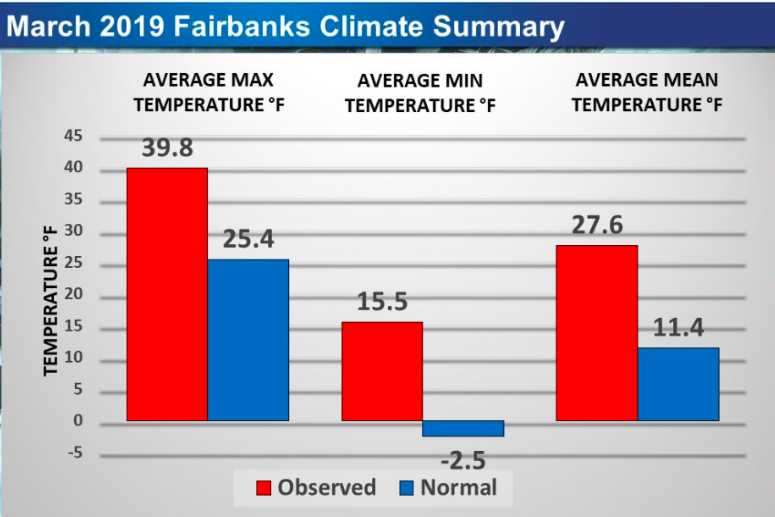Anchorage has had an air show for the past week. Above, F-22 Raptors from the 3rd Wing and 477th Fighter Group in a close formation taxi with an E-3 Sentry and a C-17 Globemaster III following, in what’s known as an Elephant Walk, March 26, during the Polar Force exercise at JBER. The two-week exercise gives squadrons an opportunity to demonstrate their abilities to forward deploy and deliver overwhelming combat airpower. (Air Force photo / Justin Connaher)
- Since record keeping began in 1921, the average monthly temperature in March in Utqiaġvik (Barrow) has never been above 0°F, until March, 2019, when it was +5.9°F.
- Fairbanks also set record highs for March, according to the National Weather Service:

- Today marks the day when 43 Klondike miners were buried in an avalanche in the Chilkoot Pass, in the deadliest event of the gold rush. Known as the Palm Sunday Avalanche, it was the most widely written news story of the Gold Rush, second only to the initial report of the massive gold finds in the Yukon. You can learn more about it here.

It is a bit ironic that all the military jets are shown with the data supporting the “unseasonably” high temps for Fairbanks in March since “jets” are one of the largest contributors to greenhouse gases in our atmosphere?
John Schandelmeier just did a good story for ADN that outlines his observations around the Fairbanks area.
“Warm, dry weather has consequences everywhere in the state. Fairbanks was on track to have the warmest March on record. Should “warm” become the trend, the effect on permafrost will be dramatic. It is not about high temperatures, but the number of thaw days.”
As permafrost thaws further in Alaska more “greenhouse” gases like Methane will further exacerbate the warming trends seen throughout the state.
“Another effect of the spring of 2019 will be travel between villages along the Yukon and Kuskokwim rivers. Snowmachines are the common choice for villagers traveling between communities throughout winter and well into spring. Ice along all of the main river systems is significantly thinner than normal — thus dangerous — especially near creek mouths and on the outside of bends.”
We are already seeing the effects of thinning ice this year as fatalities have been recorded from Big Lake to Bethel.
https://www.adn.com/outdoors-adventure/2019/04/03/what-happened-to-winter-in-march/
“The “Liscomb Bone Bed” along the Colville River in Alaska’s North Slope is full of duck-billed dinosaur fossils.
Over 99 percent of the 6,000 dinosaur fossils pulled from the quarry are hadrosaurines, a branch of the hadrosaur, or non-crested duck-billed dinosaur tree….”
http://mustreadalaska.com/new-arctic-dinosaur-fossils-discovered-in-colville-river/
I would have added “Additional dinosaur fossils discovered…” but that’s just me I guess. Either way, the point is our little globe in this vast universe has been changing for a very very long time and it will continue to change. What we can do is to adapt the best way we can, just like the once nomadic tribes in Alaska used to.
Comments are closed.